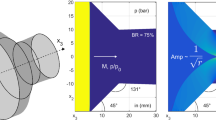Abstract
The dynamics of detonation waves propagating in a confined supersonic flow is numerically investigated to understand the effects of incoming flow velocity in a combustion chamber on detonation properties and structure. The computational code is based on the Euler equations with detailed chemistry. The detonation is directly initiated with high pressure and temperature at a given region inside a straight tube and then propagates both upstream and downstream. The study shows that as the incoming flow velocity increases, the properties of the detonation wave moving upstream and downstream are significantly changed. This leads to an increase or decrease in the velocity and strength of the detonation wave, and a change in smoked foil cellular pattern. It was found that the strength of the upstream-moving detonation becomes higher and the propagation velocity decreases as the incoming velocity increases. These factors result in a change of the smoked foil pattern such as the cell length, width, and track angle. Moreover, the time in stabilizing the detonations moving in opposite directions is significantly changed with a supersonic incoming flow. An initiation delay occurs on the downstream-moving detonation since it is weakened in a supersonic flow.















Similar content being viewed by others
References
Fickett, W., Davis, W.C.: Detonation: Theory and Experiment. Dover Publications, Mineola (2000)
Lee, J.H.S.: The Detonation Phenomenon. Cambridge University Press, New York (2008)
Oran, E.S., Weber, J.W., Stefaniw, E.I., Lefebvre, M.H., Anderson, J.D.: A numerical study of a two-dimensional \({\rm H}_{2}\)-\({\rm O}_{2}\)-Ar detonation using a detailed chemical reaction model. Combust. Flame 113, 147–163 (1998)
Hu, X.Y., Zhang, D.L., Khoo, B.C., Jiang, Z.L.: The structure and evolution of a two-dimensional \({\rm H}_{2}/{\rm O}_{2}\)/Ar cellular detonation. Shock Waves 14, 37–44 (2005)
Deiterding, R.: Parallel adaptive simulation of multi-dimensional detonation structures, PhD Dissertation, Brandenburgische Technische Universität, Germany (2003)
Carrier, G.F., Fendell, F.E., Fink, S.F.: Nonintrusive stabilization of a conical detonation wave for supersonic combustion. Combust. Flame 103, 281–295 (1995)
Wilson, D.R., Lu,F.K., Kim, H.Y., Munipalli, R.: Analysis of a pulsed normal detonation wave concept. AIAA 2001-17845 (2001)
Yi, T.H., Wilson, D.R., Lu, F.K.: Numerical study of unsteady detonation wave propagation in a supersonic combustion chamber. In: Jagadeesh, G., Arunan, E., Reddy, K.P.J. (eds.) Proceedings of the 25th International Symposium on Shock Waves. Paper No. 10041, Universities Press, Andhra Pradesh, India (2006)
Levin, V.A., Vladimir, V.V., Markov,V., Zhuravskaya, T.A., Osinkin, S.F.: Initiation of detonation in the supersonic gas flow. In: Proceedings of the 21st International Colloquium on the Dynamics of Explosions and Reactive Systems, 79 (CD), Poitiers, France (2007)
Ishii, K., Kataoka, H., Kojima, T.: Initiation and propagation of detonation waves in combustible high speed flows. Proc. Combust. Inst. 32, 2323–2330 (2009)
Vasilev, A.A., Zvegintsev, V.I., Nalivaichenko, D.G.: Detonation waves in a reactive supersonic flow. Combust. Explos. Shock Waves 42, 568–581 (2006)
Yi, T.H., Anderson, D.A., Wilson, D.R., Lu, F.K.: Numerical study of two-dimensional viscous, chemically reacting flow. AIAA 2005-4868 (2005)
Brown, P.N., Byrne, G.D., Hindmarsh, A.C.: VODE: a variable-coefficient ODE solver. SIAM J. Sci. Stat. Comput. 10, 1038–1051 (1989)
Smith, G.P., Golden, D.M., Frenklach, M., Moriarty, N.W., Eiteneer, B., Goldenberg, M., Bowman, C.T., Hanson, R.K., Song, S., Gardiner, Jr., W.C., Lissianski, V.V.: GRI-Mech 3.0. http://combustion.berkeley.edu/gri-mech/
MacNeice, P., Olson, K.M., Mobarry, C., deFainchtein, R., Packer, C.: PARAMESH: a parallel adaptive mesh refinement community toolkit. Comput. Phys. Commun. 126, 330–354 (2000)
Tannehill, J.C., Anderson, D.A., Pletcher, R.H.: Computational Fluid Mechanics and Heat Transfer. Taylor & Francis, Washington (1997)
Gordon, S., McBride, B.J.: Computer program for calculation of complex chemical equilibrium compositions and application I. Analysis. NASA RP-1311 (1976)
Kee, R.J., Coltrin, M., Glarborg, P.: Chemically Reacting Flow. Wiley, New Jersey (2003)
Turns, S.R.: An Introduction to Combustion: Concepts and Application. McGraw-Hill, New Jersey (1996)
Leveque, R.J.: Finite Volume Methods for Hyperbolic Problems. Cambridge University Press, New York (2002)
Bussing, T., Pappas, G.: An introduction to pulse detonation engines. AIAA 94-0263 (1994)
Schultz, E., Shepherd, J.E.: Validation of detailed reaction mechanisms for detonation simulation. FM99-5, California Institute of Technology (2000)
Konnov, A.A.: Detailed reaction mechanism for small hydrocarbons combustion. 15th JOURNEES D’ETUDES of the Belgian Section of the Combustion Institute (1996)
Tan, Y., Dagaut, P., Cathonnet, M., Boettner, J.C., Bachman, J.S., Carlier, P.: Natural gas and blends oxidation and ignition: experiments and modeling. In: 25th International Symposium on Combustion, vol. 25, pp. 1563–1569 (1994)
Sharpe, G.J.: Transverse wave in numerical simulation of cellular detonations. J. Fluid Mech. 447, 31–52 (2001)
Massa, L., Chauhan, M., Lu, F.K.: Detonation turbulence interaction. Combust. Flame 158, 1788–1806 (2011)
Author information
Authors and Affiliations
Corresponding author
Additional information
Communicated by L. Bauwens.
Rights and permissions
About this article
Cite this article
Yi, T.H., Lu, F.K., Wilson, D.R. et al. Numerical study of detonation wave propagation in a confined supersonic flow. Shock Waves 27, 395–408 (2017). https://doi.org/10.1007/s00193-016-0666-8
Received:
Revised:
Accepted:
Published:
Issue Date:
DOI: https://doi.org/10.1007/s00193-016-0666-8



